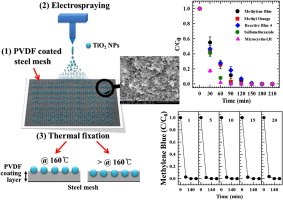Publication
Advanced Redox Technology Lab
Publication
Advanced Redox Technology Lab
Journal papers
We have developed a highly reusable photocatalyst based on TiO2 nanoparticles for degrading organic pollutants in water. The particles were immobilized on steel mesh (SM) by a three-step procedure: (1) formation of poly(vinylidene fluoride) (PVDF) binder interface by dip-coating SM (2.5 cm × 5.0 cm), (2) electrospraying of TiO2 nanoparticles dispersed in methanol (Degussa P25, 1 mg/mL), and (3) final thermal fixation with a pressure of 100 MPa for improved mechanical stability. When the electrosprayed volumes were 10, 20, 30, 40, 50, and 60 mL, the TiO2 loading on both sides of the PVDF-coated SM increased from 0.20, 0.43, 0.73, 0.97, 1.10, to 1.60 mg respectively. The SM sample loaded with 1.10 mg TiO2 (SM-TiO2) was found to be optimal for the photocatalytic oxidation of methylene blue (MB) under UV irradiation, with stable performance for 20 consecutive photocatalytic runs. The SM-TiO2 thermally fixed at 160 °C exhibited higher photocatalytic efficacy than those fixed at 180 and 200 °C, because at higher temperatures the melted PVDF resin layer (melting point: 165–172 °C) entrapped the TiO2 nanoparticles and rendered them photocatalytically inactive. The optimized SM-TiO2 demonstrated good performance on diverse organic pollutants, namely MB, methyl orange, reactive blue 4, sulfamethoxazole, and microcystin-LR, with rate constants of 0.0251, 0.0368, 0.0164, 0.0568, and 0.0725 min−1, respectively.
